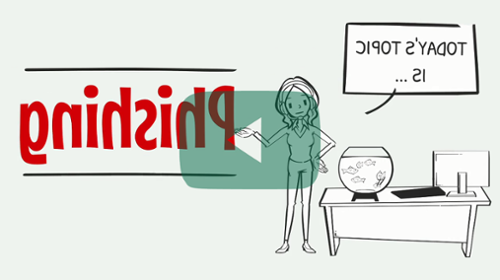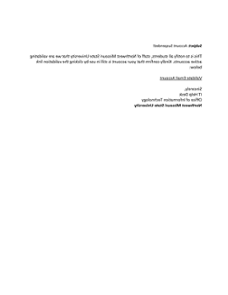电子邮件已经 伟大的 importance in business and education and its impact on daily communication practices is undeniable and far-reaching. 每天都有数以百万计 电子邮件 are sent from companies to customers, employees to other employees and students to faculty. Northwest provides each member of its campus community, 包括其认可的组织, with University email accounts via Office 365 (Outlook).
你 & 电子邮件诈骗
什么是网络钓鱼?
Phishing is a form of fraud or theft by deceit! Similar to a fisherman using a lure to catch a fish, the fraud takes the form of an individual or individuals pretending to be a legitimate company or person in an email, text message or other social media communication method in order to obtain your login credentials or sensitive account information.
Typically a victim will receive a message that appears to be sent by a known contact or reputable organization with an attachment or link to click on. The attachment or link will typically install malware on the victim's device or direct the victim to a malicious web page to trick the victim into divulging their personal and/or financial information such as passwords, social security numbers and credit card details.
To make phishing messages look like they are genuine, the sender will include logos and information taken from a legitimate institution's web site and even have a similar (but different) email address.
注意,不要上钩!
|
 |
How do I protect myself from becoming a victim?
- Don't email personal or financial information through email! Email is not a secure method of transmitting sensitive personal information!
- Never click on a link in an email unless you are absolutely sure the message is legitimate! 简而言之, thoroughly investigate the email message and see if there is an alternative way to get the information without clicking on the link in your email!
- Always be cautious about clicking on all links, opening any attachments or downloading files from 电子邮件 regardless of who sent the email. 它们可能包含病毒和恶意软件!
- Look critically at the full email address not just the first few words to see if the email is a legitimate email address at the institution or company!
- If it is from a credit card company or bank that you are affiliated with, call the bank or credit card company or go directly to their web site to investigate the email.
- Only provide personal or financial information through an organization's official web site!
- Critically look at the organization's web site address! Is it their legitimate "secure" address or is misdirecting you to a phony web site!
- If you accidentally do click on a link in your email and realize it was a mistake, 立即更改所有密码, check for Rules that may have been set up in Outlook to delete or misdirect your email.
- Delete suspicious 电子邮件 and/or report them by forwarding the 电子邮件 to appropriate IT security staff of the institution that provides you with your email, 社交媒体或电话服务.
|
了解网络钓鱼诈骗!
观看全国网赌正规平台的视频 >
|
 |
如何自我举报可疑电邮讯息?
- 在电脑或平板电脑上打开Outlook应用程序.
- Open the suspicious message in a separate window (i.e. 不是阅读区).
- In the message window ribbon bar, click on Message Actions.
- Occasionally the Message Actions button is not visible unless you enlarge the message window to be full-screen.
- 在右侧面板中,单击Report & 提供反馈按钮.
- 然后网页浏览器会打开一个页面. Select the option that best describes why you are reporting the message.
- The message will then be deleted from your mailbox and will be sent directly to the administrators for review.
Self-reporting messages is the fastest and most efficient way to help Northwest manage spam/phishing attacks and further reduce the impact on others at the University.
What should I do if I responded to a suspicious email and provided my login information?
- Immediately change your password for your Northwest Network Account. Choose a new password that is completely different than what you previously had for a password.
- Check to ensure that your direct deposit information has not been changed by doing the following:
- Log into CatPaws and go the Account Payment Center.
- 选择右侧的直接存款选项.
- Verify that the account information listed is your account and not one that you don't recognize.
- If you are in doubt about the account listed, delete what is there.
- When you have your correct bank account information, add it back into the direct deposit section of the Account Payment Center.
Below are just some examples of phishing schemes seen by Northwest email users. Please do not assume an email message is safe if it is not listed here! There are many variants of the following 电子邮件 and new phishing 电子邮件 are sent out each day! 当有疑问时,不要点击! Instead consult with appropriate IT support staff!



